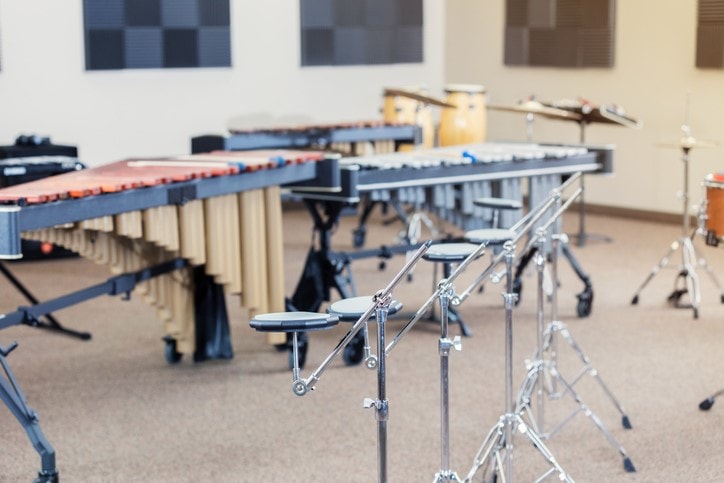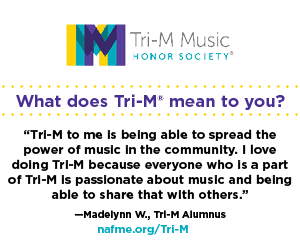/ News Posts / Make It Stick: Implement Rehearsal Routines
Make It Stick
Implement Rehearsal Routines
By NAfME Member Lori Schwartz Reichl
This article was originally published in the February 2018 teacher edition of In Tune Magazine.
“The secret of your future is hidden in your daily routine.” ~ Mike Murdock
The first fourteen years of my teaching career occurred during the time of my life when I was not a mother. However, during these childless years, I treated the students in my care as though they were my family. I concentrated my daily energy on connecting with my students, managing a successful classroom, and instilling efficient rehearsal routines. The musical outcome of my ensembles proved that the daily routines I implemented were effective in developing musicianship and building high quality programs. When I became a mother, my greatest concern became raising my own happy and healthy children. In attempting to achieve this goal, my husband and I researched childhood behavior. Almost every article, book, or pamphlet we read encouraged us to create daily routines for our children at home. Time and again, we read how children do best when routines are regular, predictable, and consistent. Routines provide children with a sense of security and structure and can influence emotional, cognitive, and social development.
The same is true for a classroom or rehearsal space. If implemented purposefully, routines can enhance organization, eliminate chaos, ensure safety, focus students’ attention, and save precious rehearsal time. If implemented passionately, routines can also unite students to perform more musically as a cohesive unit. Depending on the age or musical level of the musicians, more or less time may be required for specific routines.
Routines must be established before music is performed. Create routines for how you, as the conductor, productively begin and end each rehearsal. Greet students at the door you expect them to use to enter the room. Don’t converse with colleagues, hover in your office, type on your computer, or access your cell phone. Show your students you are excited to see them and eager to make music together by being present to greet them. Make eye contact with each student and smile as they enter. Be jovial. Compliment them on their appearance or a recent accomplishment. Discuss an interest with them, such as fashion, news, or sports. Your attention, smile, or kind word could be the only compassion they experience that day. This alone could inspire them to perform at their highest level both behaviorally and musically. Upon dismissal, offer students a high-five, fist bump, or musical praise. If necessary, offer an individual behavioral warning or musical critique as they exit.
Your attention, smile, or kind word could be the only compassion they experience that day. This alone could inspire them to perform at their highest level both behaviorally and musically.
Create routines for how students will obtain materials, where they will rest their belongings, when and where they should assemble their instruments, and how and where they may store their instrument cases. Not only will this allow rehearsal to begin promptly, it will ensure the safety of students and their possessions.
Play a different musical recording each day as students enter the room. This technique can excite them, calm them, or focus their attention on a musical question. It also trains students to achieve proper audience etiquette, by listening silently when music is performed.
Develop a pattern for posting each lesson agenda. If you have access to a computer and LCD projector, create your agenda in a slide show format. By doing so, you can update the slides at your convenience, rather than having to physically be in the rehearsal space to erase or write on a board. The daily agenda should include materials to be used, vocabulary to be reviewed, methods for warming up and tuning, fundamental exercises, literature to be rehearsed, and announcements to be shared.
Consider the following rehearsal routine:
- Attendance & Material Check. Formulate a quick, silent, and non-disruptive way to take attendance and check that your students have whatever materials they need each day. Nonverbal cues work well for this routine. For example, when checking for a pencil, simply raise a pencil to your own face. Encourage your students to do the same and scan each row, checking for students’ preparedness, for other items such as accessories, music, and instruments. If you don’t enforce the importance of students having a specific item in their possession, they won’t.
- Music Theory. Plan to spend as brief time, such as three to five minutes each day, on reviewing musical vocabulary, a rhythmic pattern, note values, pitch names, dynamics, articulations, or so forth. This routine can be general to music or specific to a piece of literature.
- Warm-up & Tuning. Begin with a well-known concert scale and insist that students watch you for tempo changes, dynamic contrasts, style changes, releases, and so forth. Transition to another scale and alter your conducting. By doing so, students are forced to concentrate on the conductor. If they can successfully follow your conducting during a warm-up, then they will be more apt to do so during a piece of music. Never use the same scale with the same rhythmic pattern each day. Encourage students to produce a quality tone and adjust, when necessary, for intonation concerns.
- Fundamentals. Consider using a method or chorale book and choose one or two exercises per rehearsal to execute. This routine could also include sight-reading.
- Literature. This should be the bulk of your rehearsal. If you plan to rehearse more than one musical selection, strive for contrasting repertoire. This will keep the attention of your students. Consider isolating and attacking specific sections of music, rather than always beginning at measure one of each piece.
- Announcements. Insist that students’ “eyes and ears” are on you while you are speaking. If they aren’t watching you, they probably aren’t listening either. If announcements are made at the beginning of class, students may not yet be focused and retain information, as they could still be setting-up materials. However, don’t include announcements as the very last part of the rehearsal either. If you do, students will be eager to gather their belongings and/or disassemble their instruments to pack up, without listening.
- Performance. Select a piece of music or phrase to perform that you feel the students have improved upon or mastered during the rehearsal. Everyone, including you, will leave the rehearsal on a positive note.
Teaching and learning will become seamless when students recognize structure and expectations.
Teaching and learning will become seamless when students recognize structure and expectations. Regardless of the routine you choose to implement or the order you determine to employ, be consistent. Make it stick!
About the author:

Photo: Richard Twigg Photography
NAfME member Lori Schwartz Reichl is a music educator and author. Visit her at makingkeychanges.com.
Lori Schwartz Reichl actively serves as an adjudicator, clinician, conductor, private instructor, speaker, and writer. Lori is the author of the series “Key Changes: Refreshing Your Music Program” published monthly for In Tune Magazine’s teacher edition where she provides resources to enhance the music classroom and rehearsal space. She also serves as a journalist for Teaching Music Magazine. Lori has worked in rural, suburban, and urban public schools and is recognized for her work with Title I schools. As an avid presenter at conferences, professional development sessions, and universities nationwide, she serves as a resource for building community, developing effective classroom management techniques and rehearsal routines, and motivating diverse learners.
Interested in reprinting this article? Please review the reprint guidelines.
The National Association for Music Education (NAfME) provides a number of forums for the sharing of information and opinion, including blogs and postings on our website, articles and columns in our magazines and journals, and postings to our Amplify member portal. Unless specifically noted, the views expressed in these media do not necessarily represent the policy or views of the Association, its officers, or its employees.
Catherina Hurlburt, Marketing Communications Manager. February 12, 2019. © National Association for Music Education (NAfME.org)
Published Date
February 12, 2019
Category
- Social Emotional Learning
Copyright
February 12, 2019. © National Association for Music Education (NAfME.org)








